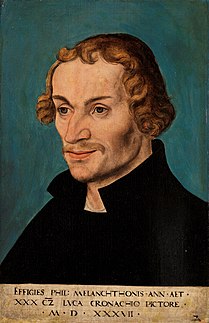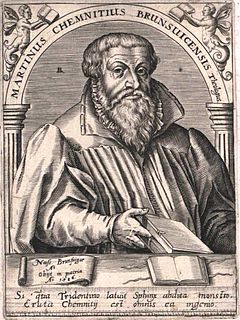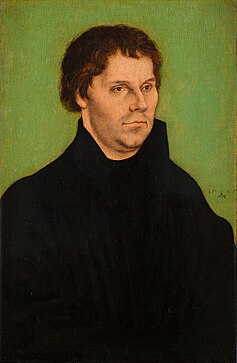
The Athanasian Creed, also known as Pseudo-Athanasian Creed or Quicunque Vult, is a Christian statement of belief focused on Trinitarian doctrine and Christology. The Latin name of the creed, Quicunque vult, is taken from the opening words, "Whosoever wishes". The creed has been used by Christian churches since the sixth century. It is the first creed in which the equality of the three persons of the Trinity is explicitly stated. It differs from the Nicene-Constantinopolitan and Apostles' Creeds in the inclusion of anathemas, or condemnations of those who disagree with the creed.

Philip Melanchthon was a German Lutheran reformer, collaborator with Martin Luther, the first systematic theologian of the Protestant Reformation, intellectual leader of the Lutheran Reformation, and an influential designer of educational systems. He stands next to Luther and John Calvin as a reformer, theologian, and moulder of Protestantism.

The Lutheran Church–Missouri Synod (LCMS), often referred to simply as the Missouri Synod, is a traditional, confessional Lutheran denomination in the United States. With slightly under 2.0 million members, it is the second-largest Lutheran body in the United States. The LCMS was organized in 1847 at a meeting in Chicago, Illinois, as the German Evangelical Lutheran Synod of Missouri, Ohio, and Other States, a name which reflected the geographic locations of the founding congregations.

Lutheran Church–Canada (LCC) is a confessional Lutheran denomination in Canada. It is the second largest Lutheran body in Canada after the Evangelical Lutheran Church in Canada (ELCIC). Together with the ELCIC and the Canadian Association of Lutheran Congregations, it is one of only three all-Canadian Lutheran denominations. LCC was founded in 1988 when Canadian congregations of the St. Louis-based Lutheran Church–Missouri Synod (LCMS) formed an autonomous church body with a synodical office in Winnipeg, Manitoba. LCC has no substantial theological divisions from LCMS and continues to have cooperative and sharing arrangements.
Crypto-Calvinism is a pejorative term describing a segment of German members of the Lutheran Church accused of secretly subscribing to Calvinist doctrine of the Eucharist in the decades immediately after the death of Martin Luther in 1546.

The Book of Concord (1580) or Concordia is the historic doctrinal standard of the Lutheran Church, consisting of ten credal documents recognized as authoritative in Lutheranism since the 16th century. They are also known as the symbolical books of the Evangelical Lutheran Church.

Confessional Lutheranism is a name used by Lutherans to designate those who accept the doctrines taught in the Book of Concord of 1580 in their entirety because (quia) they are completely faithful to the teachings of the Bible. Confessional Lutherans maintain that faithfulness to the Book of Concord which is a summary of the teachings found in Scripture, requires attention to how that faith is actually being preached, taught, and put into practice. Confessional Lutherans believe that this is a vital part of their identity as Lutherans.

Martin Chemnitz was an eminent second-generation German, Evangelical Lutheran, Christian theologian, and a Protestant reformer, churchman, and confessor. In the Evangelical Lutheran tradition he is known as Alter Martinus, the "Second Martin": Si Martinus non fuisset, Martinus vix stetisset goes a common saying concerning him. He is listed and remembered in the Calendar of Saints and Commemorations in the Liturgical Church Year as a pastor and confessor in the Lutheran Book of Worship (1978) and subsequent Evangelical Lutheran Worship (2005) used by the Evangelical Lutheran Church in America.

The Apology of the Augsburg Confession was written by Philipp Melanchthon during and after the 1530 Diet of Augsburg as a response to the Pontifical Confutation of the Augsburg Confession, Charles V's commissioned official Roman Catholic response to the Lutheran Augsburg Confession of June 25, 1530. It was intended to be a defense of the Augsburg Confession and a refutation of the Confutation. It was signed as a confession of faith by leading Lutheran magnates and clergy at the meeting of the Smalcald League in February, 1537, and subsequently included in the German [1580] and Latin [1584] Book of Concord. As the longest document in the Book of Concord it offers the most detailed Lutheran response to the Roman Catholicism of that day as well as an extensive Lutheran exposition of the doctrine of Justification.

The Smalcald Articles or Schmalkald Articles are a summary of Lutheran doctrine, written by Martin Luther in 1537 for a meeting of the Schmalkaldic League in preparation for an intended ecumenical Council of the Church.

The Treatise on the Power and Primacy of the Pope (1537), The Tractate for short, is the seventh Lutheran credal document of the Book of Concord. Philip Melanchthon, its author, completed it on February 17, 1537 during the assembly of princes and theologians in Smalcald.

Formula of Concord (1577) is an authoritative Lutheran statement of faith that, in its two parts, makes up the final section of the Lutheran Corpus Doctrinae or Body of Doctrine, known as the Book of Concord.

High Church Lutheranism is a movement which began in 20th-century Europe that emphasizes worship practices and doctrines that are similar to those found within both Roman Catholicism and the Anglo-Catholic wing of Anglicanism. In the more general usage of the term it describes the general High Church characteristics of Lutheranism in the Nordic countries such as Sweden, Finland and the Baltics. The mentioned countries, once a part of the Swedish Empire, have more markedly preserved Catholic traditions.

Lutheranism as a religious movement originated in the early 16th century Holy Roman Empire as an attempt to reform the Roman Catholic Church. The movement originated with the call for a public debate regarding several issues within the Catholic Church by Martin Luther, then a professor of Bible at the young University of Wittenberg. Lutheranism soon became a wider religious and political movement within the Holy Roman Empire owing to support from key electors and the widespread adoption of the printing press. This movement soon spread throughout northern Europe and became the driving force behind the wider Protestant Reformation. Today, Lutheranism has spread from Europe to all six populated continents.
The Philippists formed a party in early Lutheranism. Their opponents were called Gnesio-Lutherans.

Lutheran orthodoxy was an era in the history of Lutheranism, which began in 1580 from the writing of the Book of Concord and ended at the Age of Enlightenment. Lutheran orthodoxy was paralleled by similar eras in Calvinism and tridentine Roman Catholicism after the Counter-Reformation.

The theology of Martin Luther was instrumental in influencing the Protestant Reformation, specifically topics dealing with Justification by Faith, the relationship between the Law and the Gospel, and various other theological ideas. Although Luther never wrote a "systematic theology" or a "summa" in the style of St. Thomas Aquinas, many of his ideas were systematized in the Lutheran Confessions.

Gnesio-Lutherans is a modern name for a theological party in the Lutheran churches, in opposition to the Philippists after the death of Martin Luther and before the Formula of Concord. In their own day they were called Flacians by their opponents and simply Lutherans by themselves. Later Flacian became to mean an adherent of Matthias Flacius' view of original sin, rejected by the Formula of Concord. In a broader meaning, the term Gnesio-Lutheran is associated mostly with the defence of the doctrine of Real Presence.

Lutheranism is one of the largest branches of Protestantism that identifies with the teachings of Martin Luther, a 16th-century German reformer. Luther's efforts to reform the theology and practice of the church launched the Protestant Reformation. The reaction of the government and church authorities to the international spread of his writings, beginning with the 95 Theses, divided Western Christianity.

The Augsburg Confession, also known as the Augustan Confession or the Augustana from its Latin name, Confessio Augustana, is the primary confession of faith of the Lutheran Church and one of the most important documents of the Protestant Reformation. The Augsburg Confession was written in both German and Latin and was presented by a number of German rulers and free-cities at the Diet of Augsburg on 24 June 1530.








